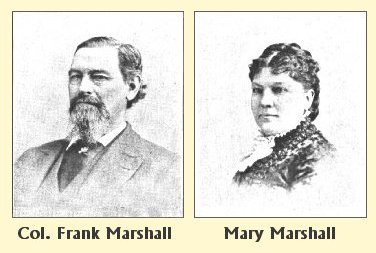Marysville & Marshall County, Kansas
Marshall County, Kansas, was named after Colonel Frank I. Marshall, who moved from Missouri in 1852 to settle near the Independence-Big Blue River Crossing in northern Kansas. Here, he established a trading post/tavern and a ferry at the crossing. The town that grew up around the tavern was then named Marysville for Marshall's wife, Mary Williams Marshall.
Camp Marysville was established here in 1857 to help protect westward-bound travelers. Marysville was a stopping point along several of the great 19th century trails:
Fort Leavenworth-Fort Kearny Military Road.
Mormon Trail-- this trail converged with the Oregon Trail at the Independence/Big Blue River Crossing.
Oregon-California Trail -- The main artery of the Oregon-California Trail (Independence Road) joined the California Trail (St. Joseph Road) just west of Marysville. This junction is where the 172-mile Independence Road ended.
California Trail (St. Joseph Road).
Pony Express Route-- The only original home station along the Pony Express Route that still stands in its original location is located at Marysville. A statue commemorating the Pony Express is located just outside Marysville.
In 1860, track laying began on the first railroad in Kansas. The Elwood & Marysville Railroad company was the first in the area. Today, Marysville is a major stopping point for the Union Pacific Railroad.
Marysville is home to several interesting historic sites, including the historic Marshall County Courthouse and Koester House Museum. It is also called the black squirrel capital, because of numerous coal-black squirrels found in the area.

Contact Our Chapter

Return to Home Page
Sidebar graphic is a detail of the tile roof of
the historic Union Pacific Depot in Marysville.

